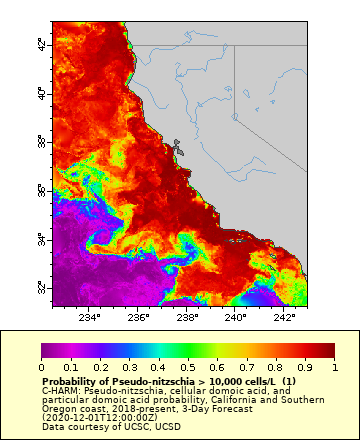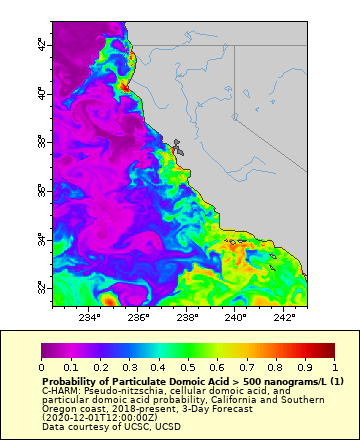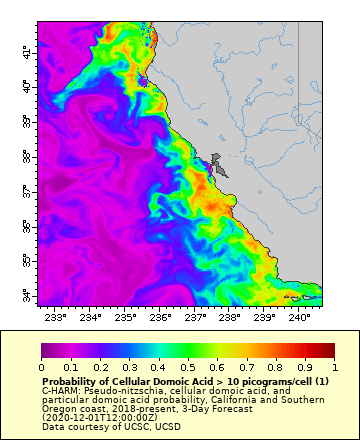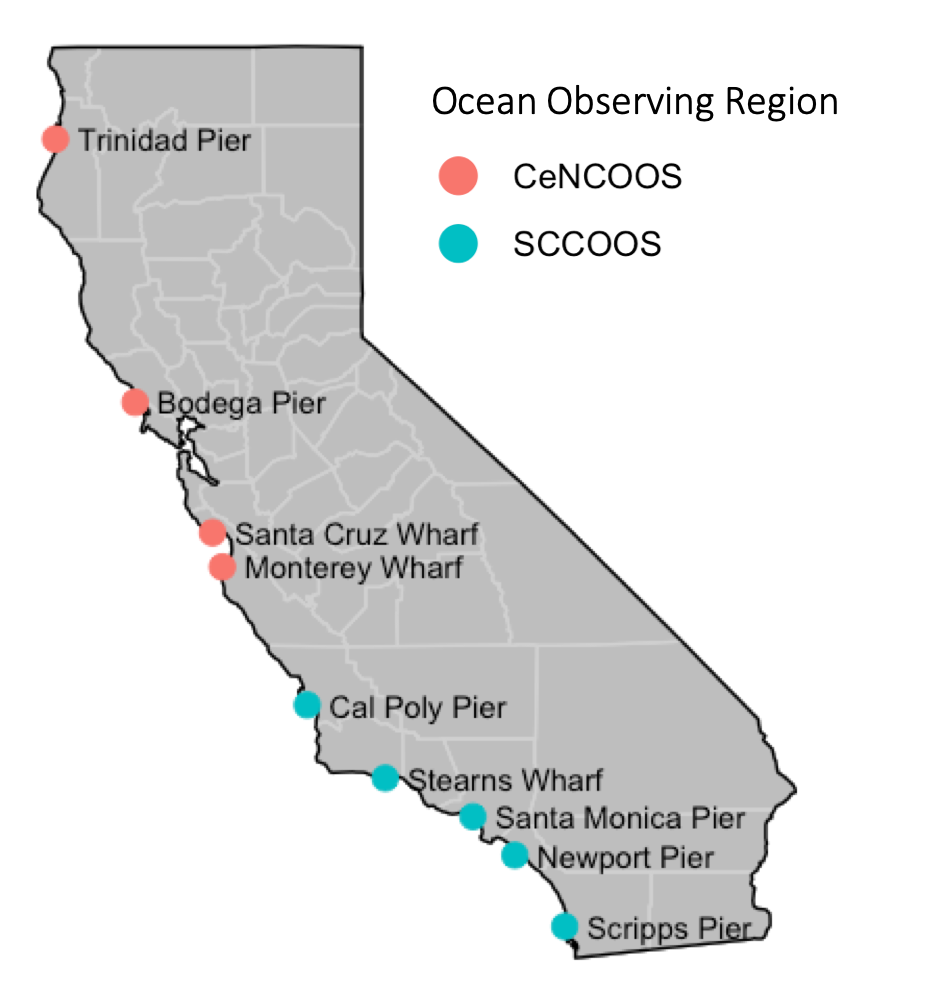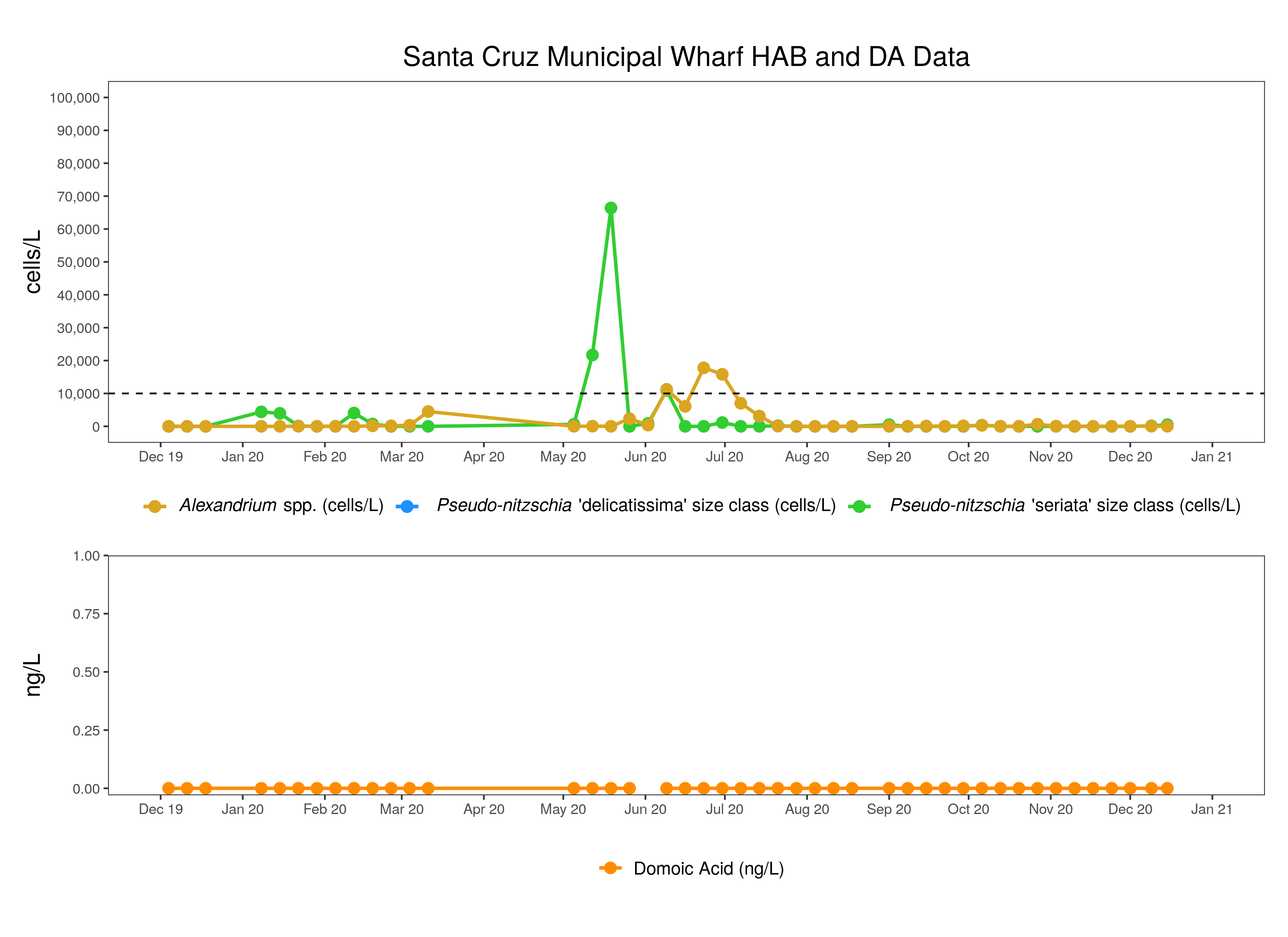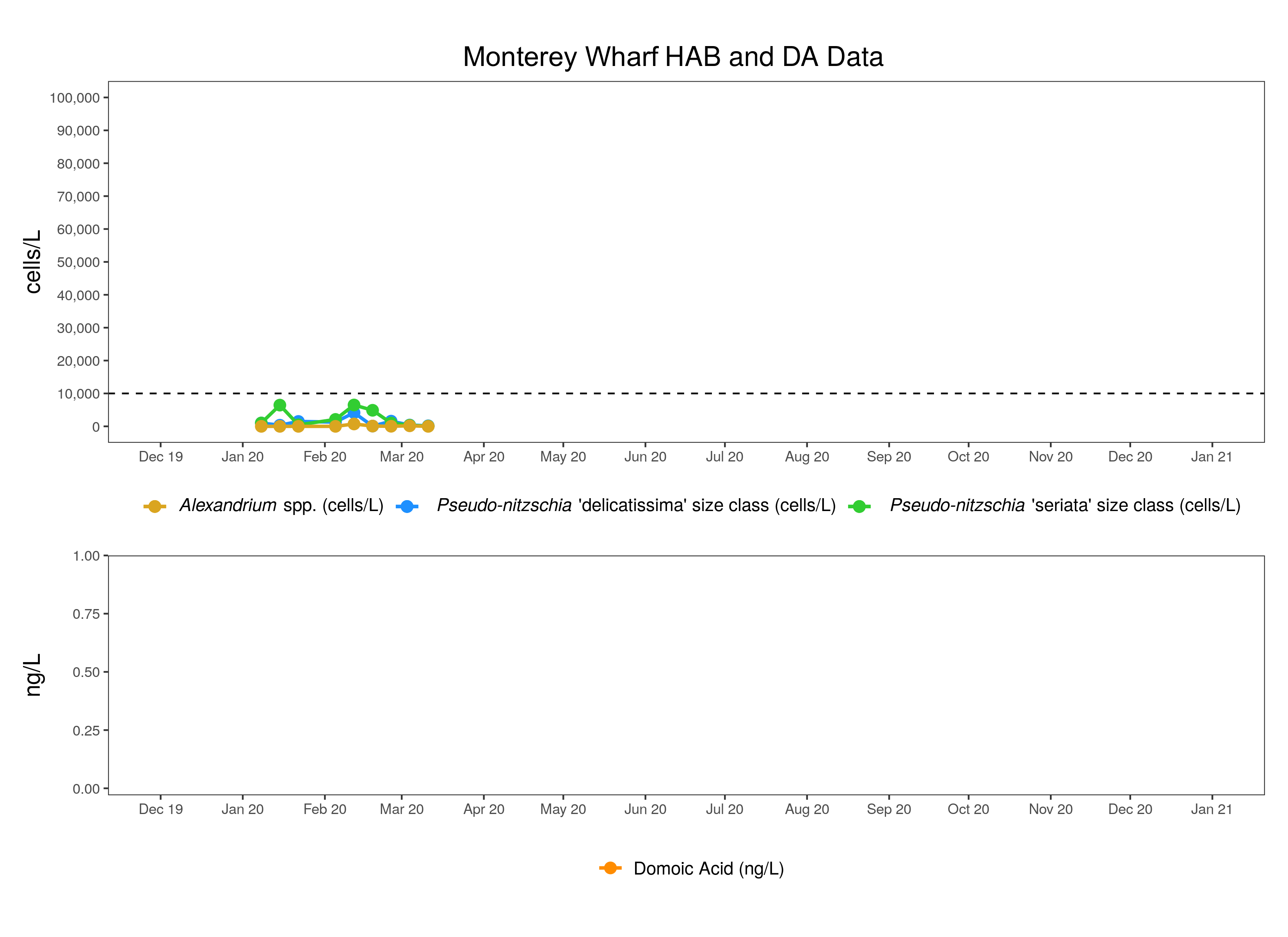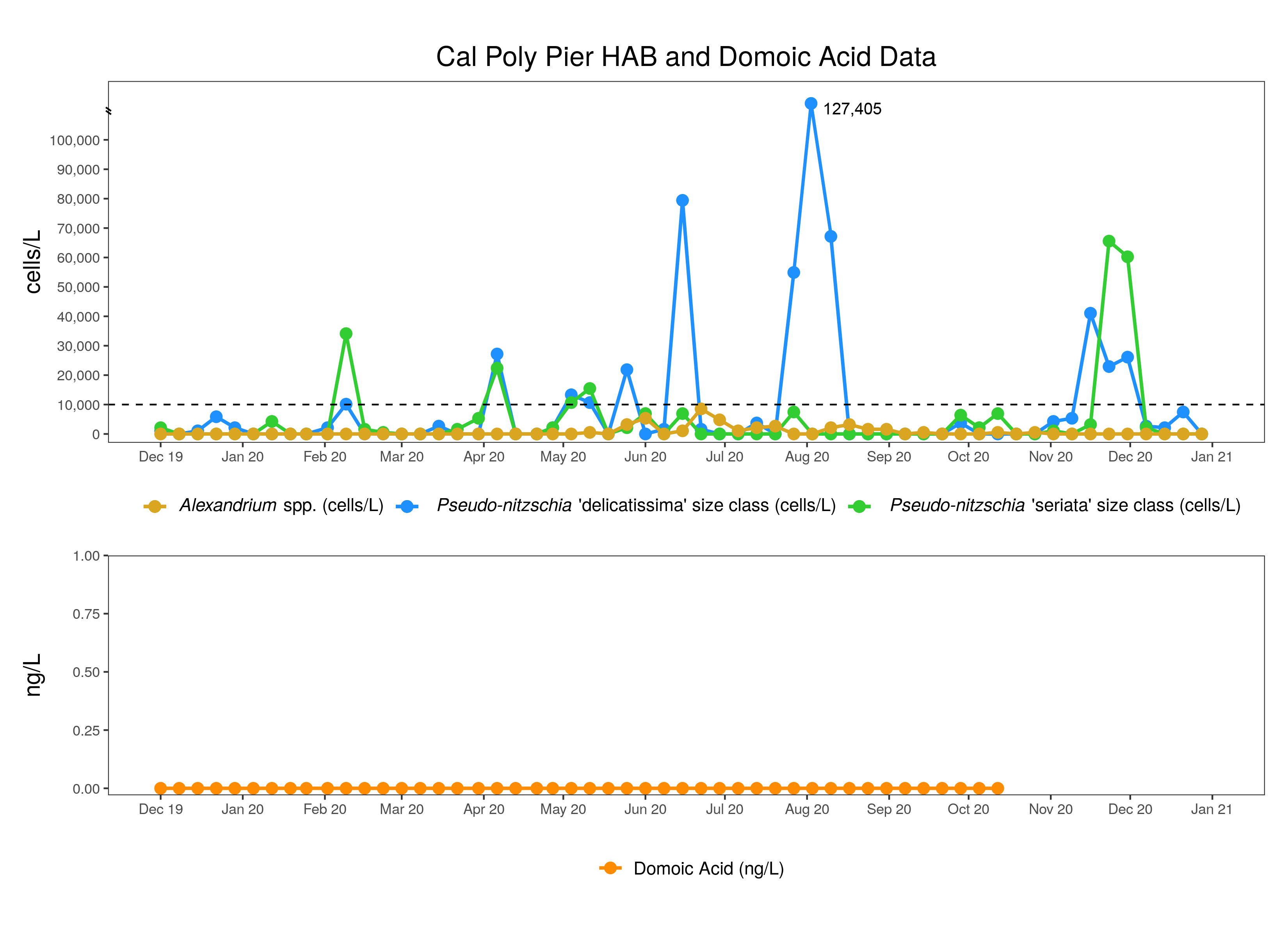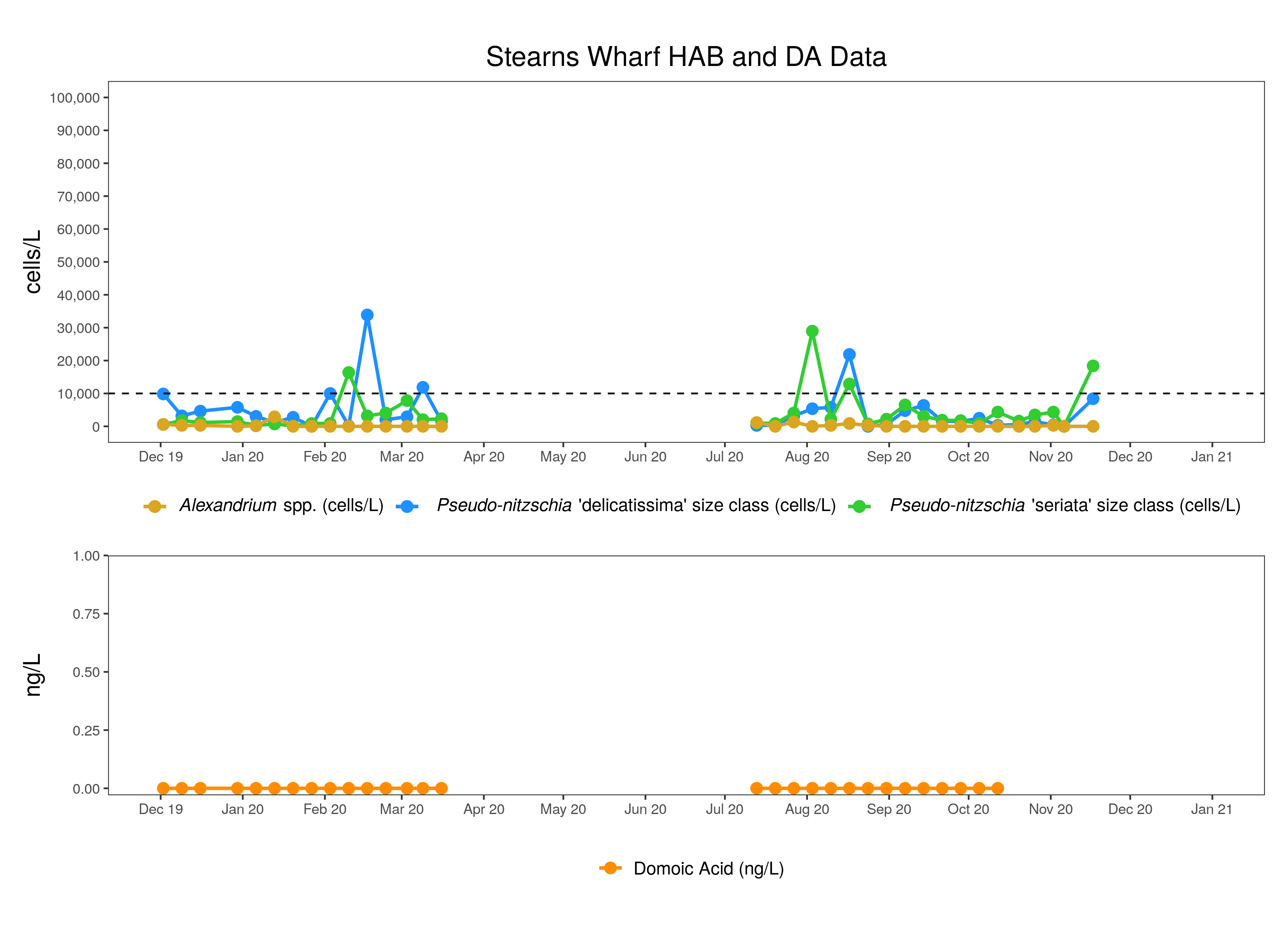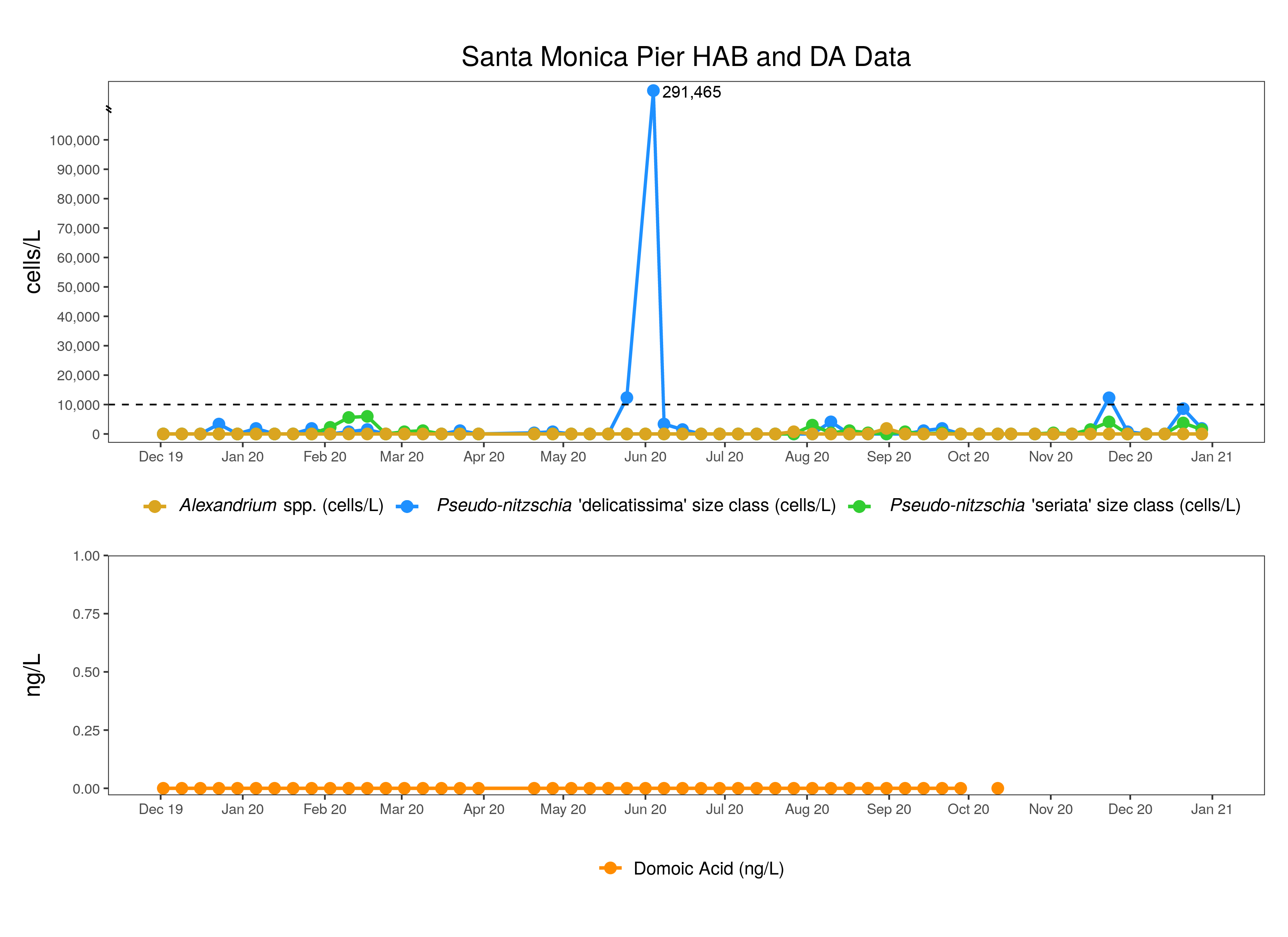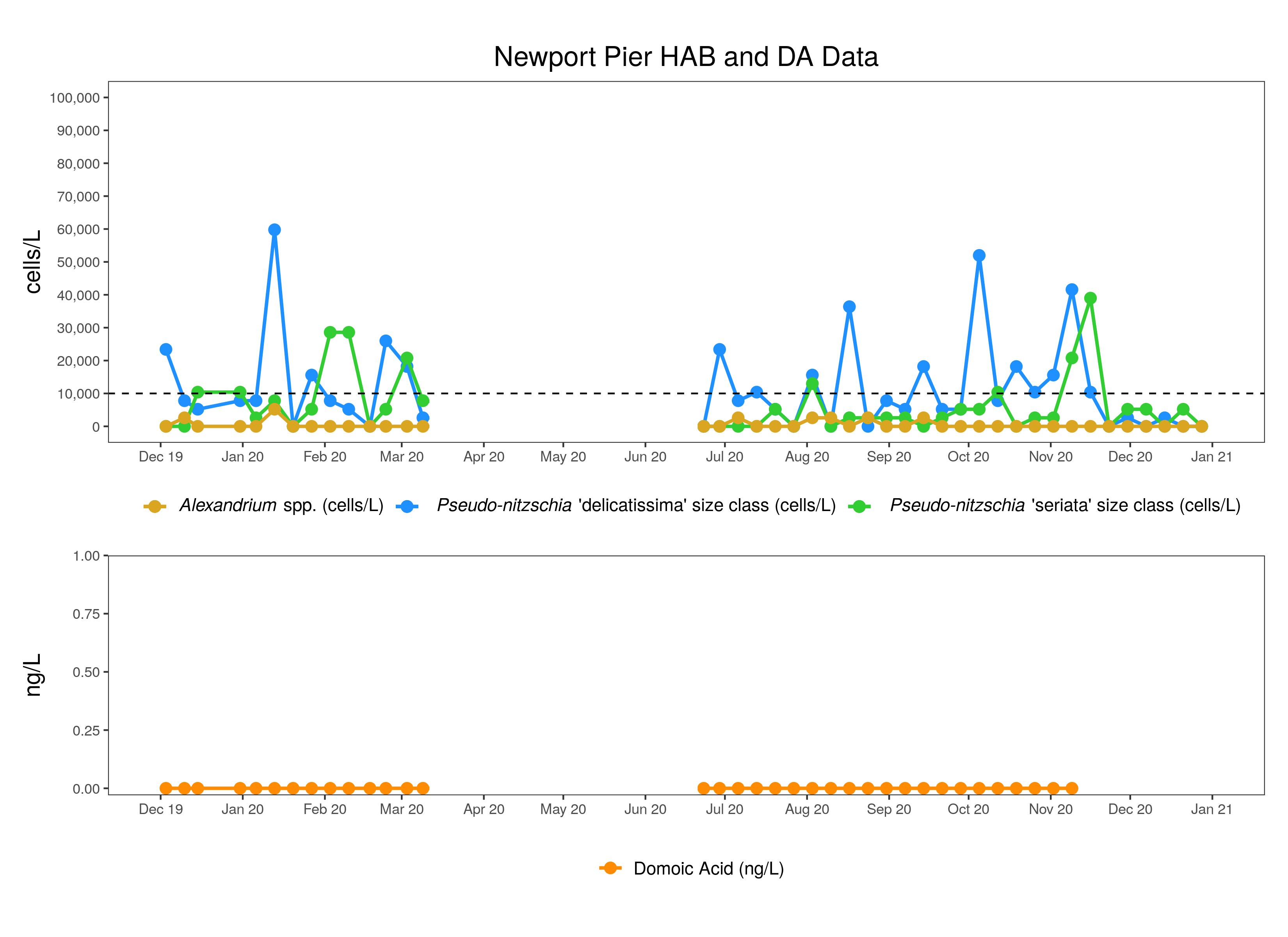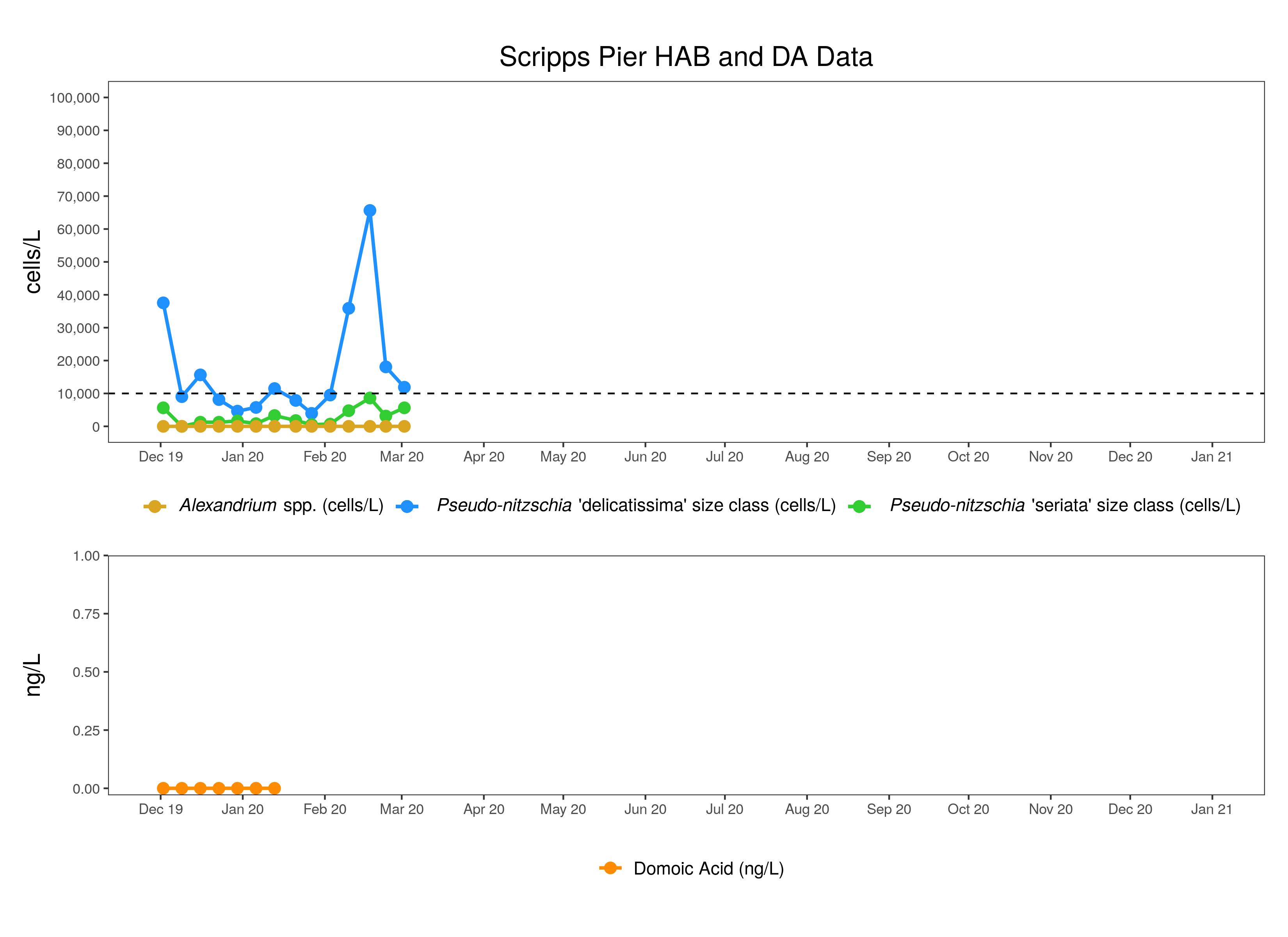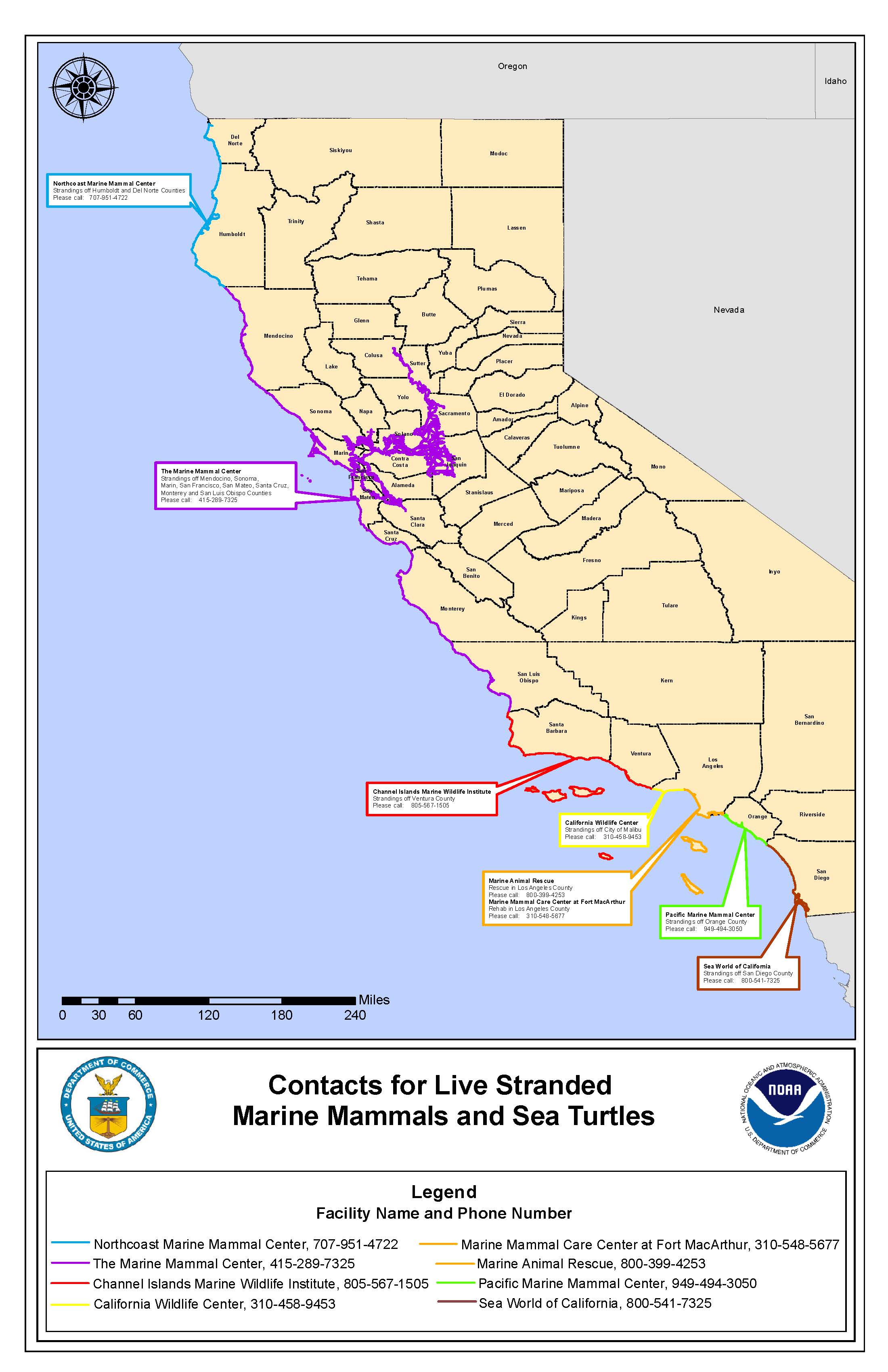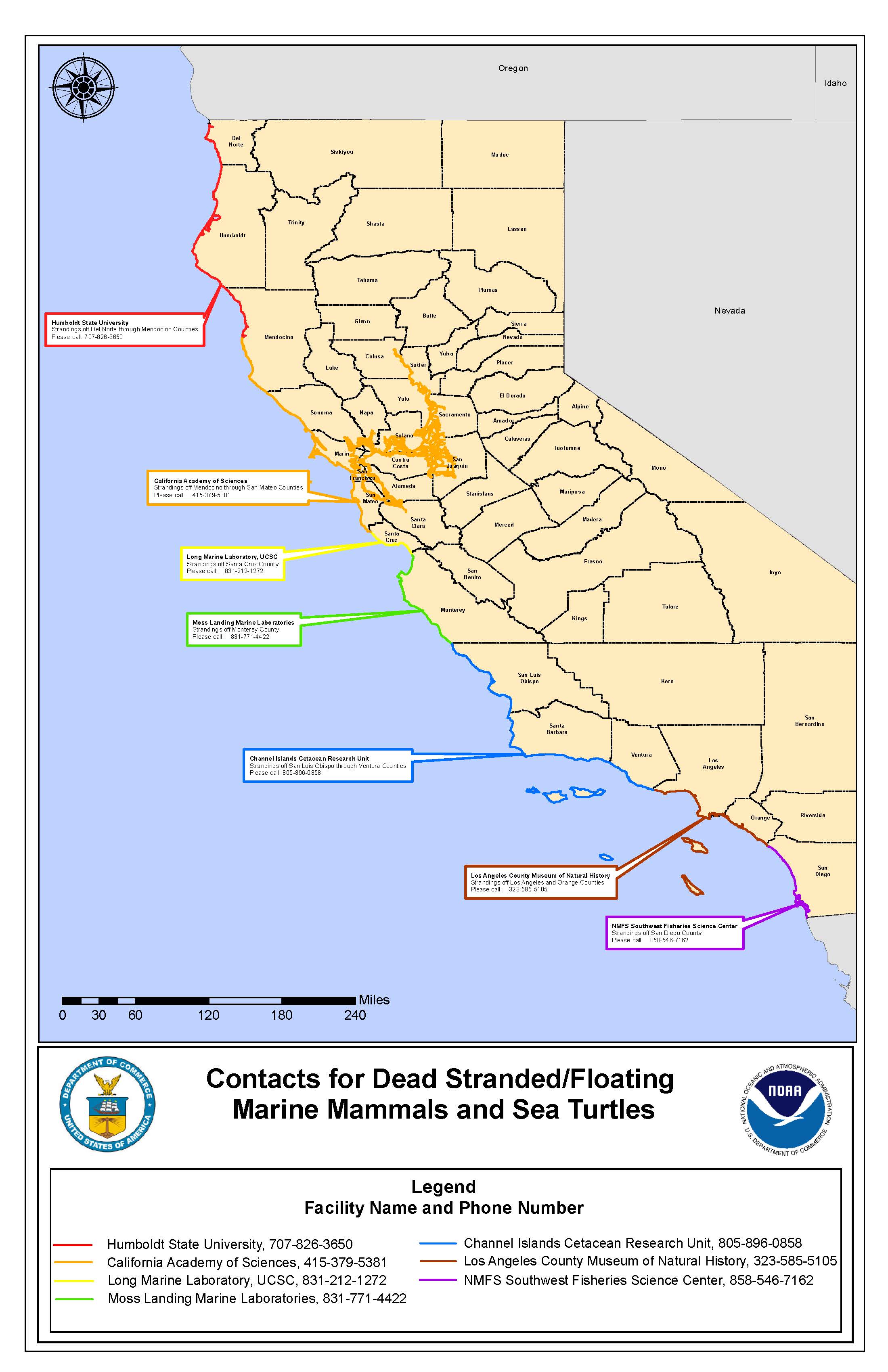Be sure to also read the special Red Tide Bulletin: Spring 2020
Pseudo-nitzschia - C-HARM tells us where conditions are suitable for species of the diatom Pseudo-nitzschia spp. (all size classes) to grow well and where they might be more likely to produce the deadly neurotoxin, domoic acid (DA). The predicted suitable habitat for Pseudo-nitzschia spp. was spread throughout coastal California from the Santa Barbara Channel to the Oregon border in December, a pattern in the C-HARM model that has persisted but with some nuances each month. This indicates that C-HARM is predicting positive habitat suitability for the genus Pseudo-nitzschia in most parts of coastal California much of the time, something that is corroborated by the frequent presence of Pseudo-nitzschia species. The most pronounced change from November is the offshore extent of persistently high bloom probabilities in December. Given ongoing COVID-19 sampling restrictions and delays that continue to hamper our ability to acquire timely HABMAP observations from piers, not all piers are currently providing data but we do know that bloom levels for both the toxigenic and nontoxigenic size class of Pseudo-nitzschia were observed only at Cal Poly Pier in December. The relatively nontoxigenic "delicatissima" size class was elevated at Santa Monica Pier but did not reach operational bloom levels. The Relative Abundance Index (RAI) for the Pseudo-nitzschia 'seriata' size class recorded by the CDPH was quite high in and around San Francisco and Tomales Bays and moderately high in areas outside the Golden Gate, such as Pacifica, a pattern that has persisted since November.
Moderate to very high C-HARM probabilities (50-100%) for particulate DA (pDA) were predicted at different times for several sections of the California coastline in December. Notable hotspots from south to north were: San Diego and Orange County regions (mid-late Dec), San Pedro Bay and surroundings, the Santa Barbara Channel (esp south of the islands and in the western channel around Pt Conception), southern San Luis Obispo coast, Monterey Bay (highly variable, mostly southern Bay and regions outside the Bay), Half Moon Bay to SF Bay, and the North Coastal region (north of Pt. Arena and with a much reduced offshore footprint relative to November). No particulate domoic acid was measured at the only HABMAP site for which December DA data are so far available (SC Wharf). Similar patterns were predicted for cellular DA (cDA) risk as those for pDA, although with some notable differences. Hotspots from south to north were: San Diego to LA County regions (mid-late Dec), the Santa Barbara Channel (mid-late Dec), San Luis Obispo region (mid-late Dec), Monterey Bay (probabilities higher than for pDA throughout the month), SF Bay and offshore (much of the month), Marin to Mendocino Co. (mid Dec), North of Pt Arena (most of the month, with a greater offshore extent than for pDA). The overall take-away this entire fall has been that cDA probabilities were frequently high along the North and Sonoma Coasts (including areas adjacent to SF Bay), suggesting a possible issue there for domoic acid. The very high probabilities for pDA (and cDA) in these hotspots is consistent with the eight California Sea Lion strandings from suspected DA toxicosis from LA, SLO, SF, Marin, and Mendocino Counties reported by The Marine Mammal Center (TMMC) and Marine Mammal Care Center Los Angeles (MCCLA).
Alexandrium - CDPH observed very low abundances of Alexandrium spp. at sites sampled in December, consistent with HABMAP sampling. However, at the end of December, CDPH issued a PSP advisory for wild-caught shellfish in Marin County after lifting a similar advisory for Humboldt County.
*Please note that HABMAP sampling, CDPH sampling, and marine mammal rescues have been greatly reduced in response to COVID-19 safety measures.
**HABMAP sampling resumed after being suspended in March 2020 in accordance with the Governor's stay at home order. However, COVID-19 safety protocols and sampling restrictions may continue to affect operations and delay results.**
Note that data for some stations are not shown because they are not yet recorded in the public HABMAP archive.
Differentiating Pseudo-nitzschia species by light microscopy is difficult. For this reason, Pseudo-nitzschia "seriata" does not refer to an actual species but rather the larger size class of Pseudo-nitzschia, which is generally a more toxigenic group of species. Alternatively, Pseudo-nitzschia "delicatissima" refers to the smaller size class that is generally non-toxigenic. The dashed line on the plots demarcates the 10,000 cells/L "bloom" threshold designated here for Pseudo-nitzschia populations only.
More information and data visualizations on the statewide HAB network and forecasting system can be found on the California HABMAP website and on the SCCOOS Harmful Algal Bloom page.
Santa Cruz Wharf
Two water samples were collected at Santa Cruz Wharf in December. Molecular probes for toxigenic Pseudo-nitzschia in the "seriata" class are conducted for this site, and was detected below bloom levels. Alexandrium spp. were detected also below bloom levels. Domoic acid results are not yet available.
The Santa Cruz Wharf shore station is supported by CeNCOOS PI Raphael Kudela at UCSC.
Monterey Wharf
Water sampling has been suspended at Monterey Wharf since March 2020 in response to COVID-19 safety measures.
Monterey Wharf shore station is supported by CeNCOOS PI's Raphael Kudela at USCS and Jason Smith and Moss Landing Marine Labs.
Cal Poly Pier
Water samples were collected 4 times at Cal Poly Pier in December. Pseudo-nitzschia "delicatissima" was detected three times (Dec 7, 14, 21) below bloom threshold values. Pseudo-nitzschia "seriata" was detected once on Dec 7. Alexandrium spp. were not detected in any sample. Domoic acid results are not yet available.
Cal Poly Pier shore station is supported by SCCOOS PI Ryan Walter and Ally Pasulka at Cal Poly.
Stearns Wharf
No samples were collected at Stearns Wharf in December.
Stearns Wharf is supported by SCCOOS PI Mark Brzezinski and Libe Washburn at UCSB.
Santa Monica Pier
Water samples were collected 4 times at Santa Monica Pier in December. Pseudo-nitzschia "delicatissima" and Pseudo-nitzschia "seriata" were detected below bloom levels twice (Dec 21, 28). Alexandrium spp. were not detected in any samples and domoic acid results are not yet available.
Santa Monica Pier shore station is supported by SCCOOS PI Rebecca Shipe at UCLA.
Newport Pier
Water samples were collected 4 times at Newport Beach Pier in December. Pseudo-nitzschia "delicatissima" was detected only on Dec 14 below bloom levels. Pseudo-nitzschia "seriata" was detected twice on Dec 7 and Dec 21 below bloom levels. Alexandrium spp. were not detected and domoic acid results are not yet available.
Newport Beach Pier is supported by SCCOOS PI David Caron at USC.
Scripps Pier
Scripps Pier water samples are not yet available for April through December 2020.
Scripps Pier is supported by SCCOOS and PIs Melissa Carter and Clarissa Anderson at UCSD.
CDPH observations for Pseudo-nitzschia 'seriata' and Alexandrium spp.
Please note, starting in July 2019, CDPH moved to only reporting Pseudo-nitzschia of the seriata complex and not all Pseudo-nitzschia spp. as previously provided.
From 1-31 December 2020, water samples were collected by volunteers and sent to the California Department of Public Health (CDPH) for analysis. Pseudo-nitzschia 'seriata' group was detected in 49 of the 75 samples. Pseudo-nitzschia 'seriata' was detected at "Common" density levels (using CDPH relative abundance index) on 9 occasions: December 5th (Pacifica Pier, 20% composition), 10th (Drakes Bay, 30%), 13th (Tomales Bay, 25% and Pacifica, 25%), 20th (Sausalito, 25% and 2 locations at Tomales, 40%), 25th (Pacifica, 30%), and 27th (Tomales, 15%). Pseudo-nitzschia 'seriata' was detected at "Abundant" density levels on 2 occasions: December 6th (Tomales, 50%) and 14th (San Fransisco Pier, 60%). Alexandrium spp. were detected in 22 of the 75 samples in the month of December. Alexandrium spp. were detected at "Present" density levels on 4 occasions or below.
You can view an interactive map and data table of CDPH data from January 2019 to present developed by SCCOOS below or you can also view CDPH Toxic Phytoplankton Observations Map with layers of Pseudo-nitzschia and Alexandrium spp. as well as other phytoplankton species observations (in the pop-up windows).
Data are provided by the California Department of Public Health, Environmental Management Branch.
CDPH and OEHHA Health Advisories
December 31. California Department of Public Health (CDPH) is advising consumers not to eat sports-harvested mussels, clams, or scallops from Marin County due to dangerous levels of paralytic shellfish poisoning (PSP) toxins being detected.
December 28. California Department of Public Health (CDPH) has lifted the November 12, 2020 shellfish safety notification today related to sport-harvested mussels, whole scallops, and clams in Humboldt County.
November 18. California Department of Public Health (CDPH) is advising consumers not to eat sport-harvested mussels, clams, or whole scallops from Mendocino County due to dangerous levels of paralytic shellfish poisoning (PSP) toxins.
October 30. CDPH announced the statewide annual quarantine on mussels gathered by sport harvesters along the California coast, except for Sonoma County, ends at midnight on Saturday, October 31, 2020. CDPH is advising consumers not to eat sports-harvested mussels, clams, or whole scallops from Sonoma County. Dangerous levels of PSP toxins have been detected in mussels from this area making them unsafe to consume.
For the latest closures and updates, please visit the CDPH Health Advisories page as a central location of information related to CDPH health advisories. Also available is a map showing the current CDPH Recreational Bivalve Shellfish Advisories (see below).
NEWS: The HAB-related illness workgroup has developed a new webpage for marine HAB-related illness tracking work (https://oehha.ca.gov/fish/general-info/marine-harmful-algal-bloom-hab-related-illness-tracking).
California Marine Mammal and Seabird Strandings from Suspected DA Toxicosis
Domoic acid (DA) is a potent neurotoxin produced by some diatom species of the genus Pseudo-nitzschia. Species exposed to DA can result in seizures, epilepsy, cardiomyopathy, and death depending upon the ingested dose. DA toxicosis commonly occurs in California Sea Lions (Zalophus californianus), presumably due to a combination of foraging behavior and seasonal movements. The Marine Mammal Center (TMMC), Channel Islands Marine Wildlife Institute (CIMWI), California Wildlife Center (CWC), Marine Mammal Care Center Los Angeles (MMCC-LA), Marine Animal Rescue (MAR), the Pacific Marine Mammal Center (PMMC), and SeaWorld act like an emergency room by working to rescue and rehabilitate sick and injured marine mammals, seabirds, and sea turtles.
Among the seven rehabilitation centers we received data for in the month of December 8 marine mammal stranding presented with symptoms of domoic acid toxicosis.
The Channel Islands Marine Wildlife Institute (CIMWI) and Pacific Marine Mammal Center (PMMC) did not record any strandings due to suspected domoic acid in December 2020.
December strandings due to suspected DA toxicosis occurred in the following counties:
- Los Angeles (MCCLA)
- December 2 - adult, female, California Sea Lion
- Marin (TMMC)
- December 17 - juvenile, male, California Sea Lion
- December 23 - juvenile, male, California Sea Lion
- San Francisco (TMMC)
- December 7 - juvenile, male, California Sea Lion
- December 17 - subadult, male, California Sea Lion
- San Luis Obispo (TMMC)
- December 8 - adult, female, California Sea Lion
- December 17 - adult, female, California Sea Lion
- Mendocino (TMMC)
- December 13 - subadult, male, California Sea Lion
At this time we do not have data from the North Coast Marine Mammal Center.
Please subscribe to CA HAB Bulletin listserv to receive the monthly CA HAB Bulletin.

